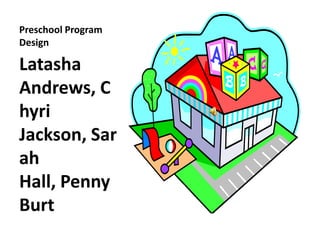Preschool program design presentation
•Download as PPTX, PDF•
3 likes•6,709 views
The preschool program design document outlines the format and stations of a preschool classroom. The classroom will include various learning stations like drama, music, literacy, and more. Each station will focus on developing social/emotional, physical, cognitive, and language skills. The drama station will include dress up and kitchen areas to encourage role play and development of cooperation and impulse control. The music station will incorporate instruments and dancing to help children understand feelings and develop social skills. The literacy and listening station will provide books, tapes, and writing materials to strengthen literacy, language, and cognitive skills.
Report
Share
Report
Share

Recommended
Recommended
More Related Content
What's hot
What's hot (20)
Ergonomics & its importance in furniture design pt 1

Ergonomics & its importance in furniture design pt 1
Architectural case Study of Utpal Sanghvi pre primary school.

Architectural case Study of Utpal Sanghvi pre primary school.
Ayushi Jain, 2nd Year Interior Design Commercial Design (Retail Design Project)

Ayushi Jain, 2nd Year Interior Design Commercial Design (Retail Design Project)
Anthropometrics and Ergonomics in Educational Spaces

Anthropometrics and Ergonomics in Educational Spaces
Desktop study international (architectural college) 1

Desktop study international (architectural college) 1
Similar to Preschool program design presentation
Similar to Preschool program design presentation (20)
Foundation Stage Curriculum Expectations Presentation

Foundation Stage Curriculum Expectations Presentation
The Little People of Tomorrow PreschoolAshley Covington, Cassa.docx

The Little People of Tomorrow PreschoolAshley Covington, Cassa.docx
The Little People of Tomorrow PreschoolAshley Covington, Cassa.docx

The Little People of Tomorrow PreschoolAshley Covington, Cassa.docx
Preschool program design presentation
- 1. Preschool Program Design Latasha Andrews, C hyri Jackson, Sar ah Hall, Penny Burt
- 2. Overview • The preschool we designed will consists of several stations like: drama station, building block/group station, library, thinking corner, cooking station, music, art, fish / water station, literacy / listening station, computer, and a discovery / Science station. • We will cover ages 2-5years of age
- 3. Within each station there will be developmental concerns: •Social/emotional •Physical •Cognitive •Language development
- 4. Latasha Andrews I will be presenting how the drama, music, and literacy/listening stations will function
- 5. The format of our preschool • Other than the stations there will be other features that make up the classroom, such as plenty of room for children in wheelchairs or other accommodations, large windows in each class, each classroom would have a bathroom, and attached outdoor playground.
- 6. Continuing format • There will be cubbies for each child in the front by the classroom entrance. They’re will be full size cubbies so that each child could put all of their items in, coats, shoes and books etc. If the students have their own cubbies, this will make them feel responsible in maintaining their personal space and prevent germs from spreading through keeping clothing separate. Right pass the cubbies would be an area for the parents to sign in/out on sheets and in this area would be mailboxes labeled with their child’s name, which would include important paperwork for the parents.
- 7. Drama station • This station would include a dress up area with a mirror and a play kitchen area with accessories. There would be babies and clothing. This would allow the children to develop socially in the drama play are by deciding roles and situations. This station would also allow children to role play events that may have occurred or may worry them. Students who engage in drama play have the skills to “cooperate with peers, control impulses, and are less aggressive”.
- 8. Drama station continue • Fine motor tasks of buttoning and dressing will work on their physical development. Cognitive development is implemented in drama play through the various roles they engage in. Some examples of cognitive learning would be a child playing cashier will most likely use math skills to add up the total. Language development is stressed through discussing and acting in the role the child has selected. Literacy is strengthened when students make props such as grocery (Dodge et al).
- 9. Music station The music will have musical instruments. This station will be near the literacy center. Music activities have been known to help children understand different feelings. By dancing to the music children will also be able to express feelings. Musical games will help children develop social skills such as “Farmer in the Dell”
- 10. This station will help develop motor skills by dancing and fine motor skills by playing of musical instruments. Music has a long history shown to improve cognitive development, like math skills that are practiced through reading music and playing notes. Music is helpful in strengthening language by the use of new words and lyrics
- 11. Literacy & Listening station: Items in the literacy center include site words, letter charts, pencil and paper. Here students can practice writing their name and the site words. Attached but separated by a barrier is the listening station. At this station students can listen to a book on tape thus improving literacy, or listen to music on tape.
- 12. Reference • (http://voices.yahoo.com) • Dodge, D., Colker, L., & Heroman, C. (2002) The Creative Curriculum (4th ed.) Washington, DC: Teaching Strategies, Inc • White, C. S., & Coleman, M. (2000).Organizing Classroom and Outdoor Learning Environments. In Early Childhood Education: Building a Philosophy for Teaching.